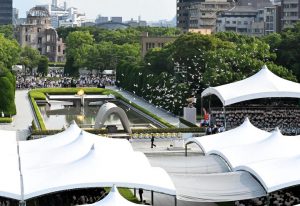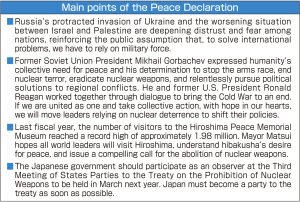Peace Declaration calls for policy shift away from nuclear deterrence, expresses sense of crisis over settling affairs by armed force 79th anniversary of atomic bombing on Hiroshima
Aug. 7, 2024
by Hiroaki Watanabe, Staff Writer
The annual Hiroshima Peace Memorial Ceremony was held in Hiroshima Peace Memorial Park in the city’s Naka Ward by the City of Hiroshima on August 6, the 79th anniversary of the atomic bombing of Hiroshima by the U.S. military. In his Peace Declaration, Hiroshima Mayor Kazumi Matsui expressed his sense of crisis over the growing public assumption that we have to rely on military force to solve international problems. He called on civil society to “be determined” and “united as one, with hope in our hearts, take collective action. Our unity will move leaders now relying on nuclear deterrence to shift their policies. We could make that happen.”
On the grounds of stepping up safety measures, the city expanded the restricted entry area, which had previously been around the Cenotaph for the A-bomb Victims, to include the entire park, including the A-bomb Dome. The city announced that approximately 50,000 people attended the ceremony, the same as last year. The newly implemented measures affected visitors, making them wait in line for baggage checks at the entrances before the ceremony began, for instance.
In his declaration, Mayor Matsui stated Russia’s protracted invasion of Ukraine and the worsening situation between Israel and Palestine are deepening distrust and fear among nations. Quoting the words of former Soviet Union President Mikhail Gorbachev, who brought the Cold War to an end, he said, “Policymakers can overcome even critical situations through resolute commitment to dialogue,” and called for the support from the public.
He also urged politicians to visit Hiroshima and issue a call for the abolition of nuclear weapons. He also requested Japan participate as an observer at the Third Meeting of States Parties to the Treaty on the Prohibition of Nuclear Weapons (TPNW) to be held next spring and become a party to the treaty.
The ceremony began at 8:00 a.m. The register of A-bomb victims, to which the names of 5,079 victims whose deaths were confirmed during the past year were newly added, was placed in the stone chest beneath the Cenotaph for the A-bomb Victims. Now the register consists of 128 volumes and 344,306 victims’ names. At 8:15 a.m., the time the atomic bomb was dropped, a representative of victims’ families and a child representative struck the Peace Bell while all attendees observed a moment of silence.
Following the Peace Declaration, two sixth-grade students read aloud their Commitment to Peace. They expressed their determination, saying, “It is up to us to protect our colorful day-to-day lives and build peace.” In his address, Prime Minister Fumio Kishida said, “No matter how arduous this path towards a world without nuclear weapons may be, we must continue moving forward along that path.” However, he did not mention the TPNW.
Representatives from 109 foreign governments, including the United States, United Kingdom, France, India, and Israel, which have nuclear weapons, and the European Union attended the ceremony. Thirty-two representatives of victims’ families from different prefectures also attended.
(Originally published on August 7, 2024)
The annual Hiroshima Peace Memorial Ceremony was held in Hiroshima Peace Memorial Park in the city’s Naka Ward by the City of Hiroshima on August 6, the 79th anniversary of the atomic bombing of Hiroshima by the U.S. military. In his Peace Declaration, Hiroshima Mayor Kazumi Matsui expressed his sense of crisis over the growing public assumption that we have to rely on military force to solve international problems. He called on civil society to “be determined” and “united as one, with hope in our hearts, take collective action. Our unity will move leaders now relying on nuclear deterrence to shift their policies. We could make that happen.”
On the grounds of stepping up safety measures, the city expanded the restricted entry area, which had previously been around the Cenotaph for the A-bomb Victims, to include the entire park, including the A-bomb Dome. The city announced that approximately 50,000 people attended the ceremony, the same as last year. The newly implemented measures affected visitors, making them wait in line for baggage checks at the entrances before the ceremony began, for instance.
In his declaration, Mayor Matsui stated Russia’s protracted invasion of Ukraine and the worsening situation between Israel and Palestine are deepening distrust and fear among nations. Quoting the words of former Soviet Union President Mikhail Gorbachev, who brought the Cold War to an end, he said, “Policymakers can overcome even critical situations through resolute commitment to dialogue,” and called for the support from the public.
He also urged politicians to visit Hiroshima and issue a call for the abolition of nuclear weapons. He also requested Japan participate as an observer at the Third Meeting of States Parties to the Treaty on the Prohibition of Nuclear Weapons (TPNW) to be held next spring and become a party to the treaty.
The ceremony began at 8:00 a.m. The register of A-bomb victims, to which the names of 5,079 victims whose deaths were confirmed during the past year were newly added, was placed in the stone chest beneath the Cenotaph for the A-bomb Victims. Now the register consists of 128 volumes and 344,306 victims’ names. At 8:15 a.m., the time the atomic bomb was dropped, a representative of victims’ families and a child representative struck the Peace Bell while all attendees observed a moment of silence.
Following the Peace Declaration, two sixth-grade students read aloud their Commitment to Peace. They expressed their determination, saying, “It is up to us to protect our colorful day-to-day lives and build peace.” In his address, Prime Minister Fumio Kishida said, “No matter how arduous this path towards a world without nuclear weapons may be, we must continue moving forward along that path.” However, he did not mention the TPNW.
Representatives from 109 foreign governments, including the United States, United Kingdom, France, India, and Israel, which have nuclear weapons, and the European Union attended the ceremony. Thirty-two representatives of victims’ families from different prefectures also attended.
(Originally published on August 7, 2024)









